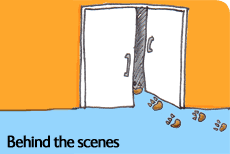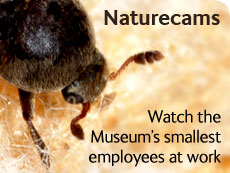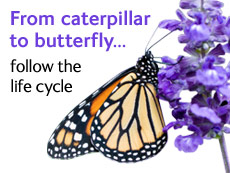Young naturalists
British wildlife is all around you. Step into your garden or visit your local park and discover hundreds of wonderful creatures, from bees to butterflies, not forgetting the wiggly worms.
Watch the video above to see some of the insects visiting our Wildlife Garden in May 2011, from ladybird larvae to flower beetles, and find out about the amazing variety you could spot in your own garden.
Explore all types of British species in these pages. Become a real life scientist, identify local wildlife, or get creative and send us your drawings and photographs. It's time to join the buzz!
-

Woodlouse identification key
This simple key will help you to identify the woodlice that you are most likely to find.
-

OPAL Kids zone
Build your own wormery, take part in a survey, play online games, and learn about the lives of British insects in the OPAL Kids zone.
-

Picture gallery
Submit your drawings and photographs of nature and you could see your art online - all wild creatures welcome.
-

I want to be an 'ologist
Would you like to be a naturalist when you grow up? Find out how some of the Museum's scientists started out.
-

Honeybees - what's the buzz?
Discover the secret lives of bees, from what goes on in a hive to how bees grow up.
-

Butterflies - follow the life cycle
Butterflies may look beautiful but they have to shed a lot of skins before the bright colours emerge. FInd out the facts.
-

Fossil hunting guide
Want to discover fossils and start your own collection? Find out how.
-

Fantastic fossils
Explore fossils found around Britain. What prehistoric creatures could you unearth?
-

OPAL Bugs Count survey
Look for mighty minibeasts living near you and go on a special quest to spot 6 bugs including leopard slugs, two-spot ladybirds and small tortoiseshell butterflies.
-

OPAL earthworm survey
Earthworms play a vital role in recycling plant nutrients and aerating the soil, but scientists still have a lot to learn about them. Help them find out more by joining the earthworm hunt in your local park or garden.
-

OPAL air survey
Find out how much pollution there is in your local area by looking for lichens, which are natural indicators of air pollution.
-

Join the Museum
Become a member of the Museum to get sneak previews of exhibitions, behind-the-scenes tours and fun free stuff including our child Members' magazine.
Toolbox

Our scientists study the snails that host the schistosomiasis parasite, which causes a disease that affects nearly 200 million people.

